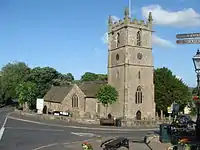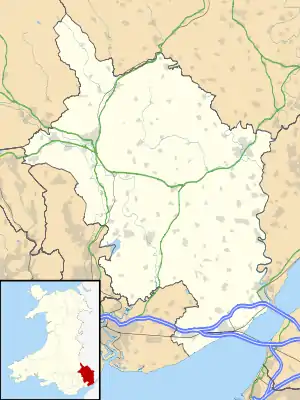St Cadoc's Church, Raglan
St Cadoc's Church, Raglan, Monmouthshire, south east Wales, is the parish church of the village of Raglan. The church is situated at a cross-roads in the centre of the village. Built originally by the Clare and Bluet families in the thirteenth and fourteenth centuries, it was rebuilt, and expanded by the Herbert's of Raglan Castle in the fifteenth century. In the nineteenth century, the church was subject to a major restoration by Thomas Henry Wyatt.
| Church of St Cadoc, Raglan, Monmouthshire | |
|---|---|
| Church of St Cadoc | |
 St Cadoc's | |
 Church of St Cadoc, Raglan, Monmouthshire Location in Monmouthshire | |
| Location | Raglan, Monmouthshire |
| Country | Wales |
| Denomination | Church in Wales |
| History | |
| Status | Parish church |
| Founded | C13th-C14th century |
| Architecture | |
| Functional status | Active |
| Heritage designation | Grade II* |
| Designated | 18 November 1980 |
| Architectural type | Church |
| Administration | |
| Parish | Raglan |
| Deanery | Raglan/Usk |
| Archdeaconry | Monmouth |
| Diocese | Monmouth |
| Clergy | |
| Vicar(s) | The Rev'd Canon Tim Clement |
Built in the Decorated style, the church is a Grade II* listed building.
History
Sir Joseph Bradney, the Monmouthshire antiquarian, described the church in his multi-volume A History of Monmouthshire from the Coming of the Normans into Wales down to the Present Time. He recorded the earliest church on the site as having been founded by Saint David, the patron saint of Wales.[1] He further noted that "for some reason which is not apparent the modern ecclesiastical authorities consider Cattwg (Cadoc) to be the patron saint".[1] Hando also noted the controversy as to the dedication, and mentioned a will dated 1494 which references "Sancta Cadoci ville de Raglan."[2] The present church was probably begun by the de Clare family, earliest Lords of Raglan,[1] and completed in the fourteenth century by the Bluets.[1] The church was greatly expanded by the Herberts of Raglan Castle, and by their successors, the Somersets, Earls and Marquesses of Worcester and Dukes of Beaufort.[1] The Beaufort (North) Chapel, constructed by the Somersets, contains three tombs of the Earls of Worcester, hereditary Lords of Raglan and of Raglan Castle in the Middle Ages.[3] Mutilated by Parliamentarian troops during the English Civil War, they represent William Somerset, 3rd Earl of Worcester, Edward Somerset, 4th Earl of Worcester and his wife, Lady Elizabeth Hastings.[3]
Charles Somerset, Marquess of Worcester, who died in a coaching accident between Raglan and Monmouth, is also buried in the church.[4] Bradney records a tablet placed in the chapel by Henry Somerset, 8th Duke of Beaufort in 1868, which details all of the Somerset interments.[1]
The church tower clock is notable for having only three faces; the Monmouthshire writer Fred Hando records that the benefactor, Miss Anna Maria Bosanquet, declined to provide a fourth face, pointing in the direction of Raglan Station, having fallen out with the station's owners.[lower-alpha 1][2]
There are also a number of memorials to the Barons Raglan, of nearby Cefntilla Court, including a stained glass window "commemorating the military exploits of FitzRoy Somerset, 1st Baron Raglan" in the Crimean War.[3]
Architecture and description
The chancel and the nave date from the fourteenth century, whilst the "fine, tall" west tower is fifteenth century.[6] The architectural historian John Newman considers the tower's diagonal buttresses "unusual" and suggests their styling dates them to similar work being carried out at Raglan Castle in the 1460s.[3] The Beaufort (North) Chapel, the resting place of many of the lords of Raglan, dates from the middle sixteenth century.[3] The font is original and was returned to the church in the 1920s, after being discovered buried in his garden by the then vicar.[5]
The rest dates predominantly from the mid-Victorian restoration carried out by Thomas Henry Wyatt in 1867-8.[3] All of the church's stained glass dates from this time. The restoration was carried out for Henry Somerset, 8th Duke of Beaufort [7] and included the construction of the Lady Chapel.[7] Re-roofing of Wyatt's nineteenth century roof in 2016 revealed the late-medieval "wagon-roof", a type of roofing common in medieval Monmouthshire.[8]
The churchyard contains the "unusually fine" base and stump of a medieval cross.[3]
Vicars since 1560
- 1560, John Gallin (Gwillim)
- 1635, William Rogers
- 1640, William Davies
- 1661, John Davies
- 1678, Rice Morris
- 1682, William Hopkins
- 1709, Richard Tyler, B.A.
- 1715, David Price
- 1746, John Leach. B.A.
- 1781, Thomas Leach. (died 1796 at Blakeney, Glos.)
- 1796, Charles Phillips, B.A.
- 1818, William Powell, M.A.
- 1866, Arthur Montague Wyatt
- 1874, Henry Plantagenet Somerset, M.A.
- 1893, Charles Mathew Perkins, M.A.
- 1903, Robert Shelley Plant.
- 1924, David James Sproule, B.A.
- 1928, Thomas Wright, B.A.
- 1939, Charles Duck, L. Div.
- 1952, William Joseph Price
- 1958, Arthur Vernon Blake, B.A.
- 1975, Peter Charles Gwynne Gower
- 1991, Simon Llewellyn Guest
- 2005, Joan Wakeling
- 2014, The Rev'd Canon Tim Clement[9]
Burials
Footnotes
- John Guy and Ewart Smith, in their study Ancient Gwent Churches, suggest that Miss Bosanquet's actions arose from a generalised dislike of railway development rather than a particularised dislike of the owners of Raglan Station.[5]
Notes
- Bradney 1992, pp. 33-8.
- Hando 1964, pp. 69–71.
- Newman 2000, pp. 488-9.
- Members Constituencies Parliaments Surveys. "SOMERSET, Charles, Marquess of Worcester (1660–98)". History of Parliament Online. Retrieved 2017-03-27.
- Guy & Smith 1980, p. 58.
- Davies 1977, p. 27.
- Good Stuff. "Church of St Cadoc, Raglan, Monmouthshire". Britishlistedbuildings.co.uk. Retrieved 2017-03-27.
- "St Cadoc, Raglan". Coflein. 2002-12-13. Retrieved 2017-03-27.
- St Cadoc's Church Guide. Mrs Horatia Durant. 1975
References
- Bradney, Joseph (1992). The Hundred of Raglan. A History of Monmouthshire. 2 (Part 1). London: Academy Books. ISBN 978-1-873361-09-2.
- Davies, E.T. (1977). A Guide to the Ancient Churches of Gwent. Pontypool, Wales: Hughes & Son Ltd. ISBN 0950049085.
- Guy, John; Smith, Ewart (1980). Ancient Gwent Churches. Newport: The Starling Press. OCLC 656714152.
- Hando, Fred (1964). Here and There in Monmouthshire. Newport: R. H. Johns. OCLC 30295639.
- Newman, John (2000). Gwent/Monmouthshire. The Buildings of Wales. London: Penguin. ISBN 0-14-071053-1.